Menstrual pains are anything but a rarity: 9 out of 10 women are affected in one form or another [1]. Dysmenorrhea is the technical term for it means "painful" or "difficult menstruation".
How it feels varies from woman to woman and from cycle to cycle: Whether you have menstrual pain and how strong they are, will depend on a variety of factors. What is sometimes only by a slight pull are felt, other times can express in strong convulsions - and vice versa. But one in three women regularly requires painkillers to cope with everyday life during their period [2].
Menstrual pain at a glance: What are the differences between primary and secondary dysmenorrhea? |
In the present moment the pain is just pain, and above all there. Medically, however, a distinction between Primary and secondary dysmenorrhea . The classification is important to determine the causes, identify potential treatment options and rule out possible diseases.
What symptoms can occur?
Whether primary or secondary menstrual pain - the basic symptoms are similar in both cases.
These symptoms may include the following:
- Abdominal pain
- Referred pain in the legs and / or back
- nausea
- vomiting
- diarrhea
- headaches
- general ill feeling.
Primary dysmenorrhea
If you suffer from primary menstrual pain, no underlying disease. Probably your pain is also 6 already 12 months after menarche (the first menstrual period) for the first time occurred [3]. In your cycle, the pain begins before or with the menstrual bleeding and keep 1-2 days [4].
It is thought that the increased production of prostaglandin - a hormone-like messenger - is responsible for the pain [3]. This may be involved in the body in different processes, depending on the place of occurrence, but takes regarding our period following double role:
On the one hand prostaglandin complicit in the initiation of menstruation: By prostaglandin can contract the uterine muscles, menstrual blood and parts to the endometrium are in the first ejected. Therefore, the body forms the end of your cycle several of the messenger. At the same prostaglandins are responsible to sensitize pain receptors.
In women with primary menstrual pain are increasingly formed prostaglandins [5]. Since the uterus to contract more strongly, blood vessels can be "pulled the trigger": the oxygen supply to the muscle tissue is temporarily interrupted, and we feel it as pain. While we are probably more sensitive to pain, can also rest periods between seizures be rarer and shorter. [5]
The increased release of prostaglandins could with other usually complaints such as nausea, headache and diarrhea are related [2].
While prostaglandins in our body take over essential functions, increased production can therefore cause unpleasant symptoms.
To whom primary menstrual pain occur?
Especially young women under 30 may be affected by primary dysmenorrhoea. Even those who have had heavy periods (menorrhagia), suffers tend often including [6].
In addition, inter alia, take a low body mass index and an early menarche and a longer period as risk factors [6]. In addition, smoking can increase the risk. And the psyche favors the pain might: Psychological factors not cause this though, but they can strengthen [7].
treatment of primary dysmenorrhea
Primary period pain are not in need of treatment in most cases. This does not mean that strong pain "normal" or we should resign ourselves to. If you do not get along during your period without painkillers, you should let the doctor clarify to exclude a secondary dysmenorrhea.
Secondary dysmenorrhea
From secondary menstrual pain is then the speech when a woman previously largely free of pain came through their days, but suddenly developed symptoms later. be the cause of this, as opposed to primary pain, usually caused by an illness.
often appear during secondary period pain only from the age of 30, is not ruled out a previous occurrence. The possible trigger for a secondary dysmenorrhea are numerous:
This may be, for example, benign tumors of the uterus, such as fibroids or polyps. Endometriosis is also a possible factor. In the latter part, years may pass is diagnosed to her.
Some women also have to insert the spiral (stronger) to fight menstrual pain.
treatment of secondary menstrual pain
In the short term can provide painkillers remedy. Medium and long term is of course the treatment of the underlying disease in the foreground, which depends on the particular clinical picture.
Step by step to greater well-being during the days
If your period pains are more easily you can also find quite a few soothing elements in your everyday noticeable relief.
Especially just before and during the period it is invaluable to have rituals, which we know that they are doing us really good.
"The" one piece of advice do not exist there. While frequently advised to use more rest, other sports experience as beneficial [5]. What helps, so can be individually; and that's what's exciting: It's time to discover your rituals and create you as your very own personal retreat. Take your time and feel this very aware of what you do well.
Whether that'll end up a gentle yoga session, a meeting with dear friends or simply means doing nothing, is entirely up to you. Always there in any case, The Hug code. With its natural ingredients you support the beneficial period Cream holistically and can not you during your days GUARANTEED down.
Each application you can both physically and mentally relax - and thus bring body and mind back more in line. Because sometimes meet quite a few little feel-good moments to you in your body to feel more at home again.

